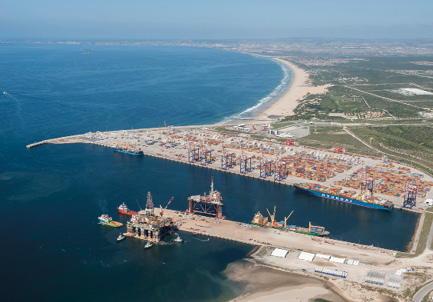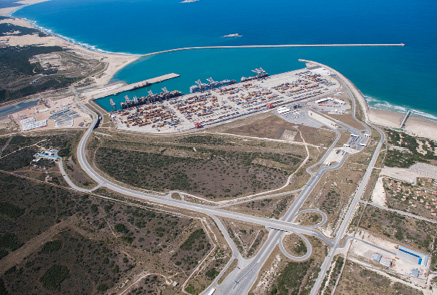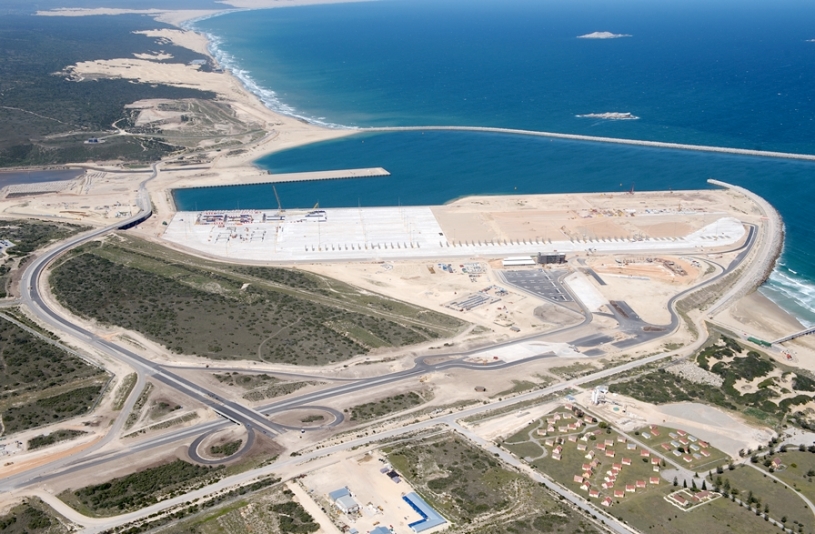Please share background on the growth and development of the Port of Ngqura?
The first phase construction of the Port of Ngqura (PoN) Greenfields project commenced in September 2002. One of the most important milestones was when the first commercial vessel, the MSC Catania, berthed at the PoN in 2009. It was officially opened on 16 March 2012 by His Excellency Dr JG Zuma, President of the Republic of South Africa. It is located in close proximity of the Coega IDZ, which provides a competitive advantage for the export and import of commodities through the port. The port is the only one in South Africa boasting an environmental authorisation Record of Decision (RoD) for its construction and operation, as well as an exceptional 0% non-compliance.
What is the relevance of having a deepwater port 20 km away from Port Elizabeth?
Well, the Port of Ngqura is a developing port, whereas the Port of Port Elizabeth is already at a maturity stage. The emerging trend in the container market is that vessels are becoming bigger and, consequently, ports are required to have deeper drafts. A decision was therefore taken to construct an industrial port to service larger vessels, with the Port of Port Elizabeth complementing Ngqura by accommodating smaller vessels. Consequently, the Port of Ngqura forms an integral part within the Coega IDZ as it supports the industrial development and the investments within the IDZ. The Port of Ngqura is being positioned as a Container Transhipment Hub for Sub-Saharan Africa and is specifically geared to serve African (East, West), European and Asian trade routes offering safe and efficient transit of cargo.
What have been some of the important milestones for the Port of Ngqura?
 The off-loading of 275 containers at the Ngqura Container Terminal (NCT) on 4 October 2009 which is operated by Transnet Port Terminals (TPT) was a moment of great celebration for all involved in the Ngqura project as it marked the unofficial opening of the port, by utilising part of the expanded port infrastructure and container terminal. Transnet National Ports Authority has recently issued a Terminal Operator License and Terminal Operator Agreement to Transnet Port Terminals to operate the Ngqura Container Terminal and the Ngqura Manganese Export Terminal. In addition, the Ports Authority is at the final stages of concluding the Terminal Operator Agreement with Oiltanking Grindrod Calulo (OTGC) for the Tank Farm operation.
The off-loading of 275 containers at the Ngqura Container Terminal (NCT) on 4 October 2009 which is operated by Transnet Port Terminals (TPT) was a moment of great celebration for all involved in the Ngqura project as it marked the unofficial opening of the port, by utilising part of the expanded port infrastructure and container terminal. Transnet National Ports Authority has recently issued a Terminal Operator License and Terminal Operator Agreement to Transnet Port Terminals to operate the Ngqura Container Terminal and the Ngqura Manganese Export Terminal. In addition, the Ports Authority is at the final stages of concluding the Terminal Operator Agreement with Oiltanking Grindrod Calulo (OTGC) for the Tank Farm operation.
What is the Port’s current capacity?
 The container terminal’ design capacity is two-metre twenty foot equivalent (TEU), and the installed capacity is 1.5 TEUs, along with a spare capacity of 1.1-million. The multipurpose terminal has capacity to handle break-bulk commodities and project cargo. While the relocation of the manganese terminal from the port of Port Elizabeth will increase the Port of Ngqura’s manganese capacity from the current 5.5 Million Tons Per Annum (Mtpa) to 16Mtpa, and the liquid bulk terminal capacity will be 2M KL (Kilolitres), once it’s relocated from the port of Port Elizabeth.
The container terminal’ design capacity is two-metre twenty foot equivalent (TEU), and the installed capacity is 1.5 TEUs, along with a spare capacity of 1.1-million. The multipurpose terminal has capacity to handle break-bulk commodities and project cargo. While the relocation of the manganese terminal from the port of Port Elizabeth will increase the Port of Ngqura’s manganese capacity from the current 5.5 Million Tons Per Annum (Mtpa) to 16Mtpa, and the liquid bulk terminal capacity will be 2M KL (Kilolitres), once it’s relocated from the port of Port Elizabeth.
What infrastructural improvements have been created in the last few years?
Transnet has installed an Automated Mooring System at the container terminal. This technology has specifically been designed and manufactured to meet certain environmental conditions in the Port of Ngqura and is tailored to enhance productivity and safety at the Container Terminal. The vacuum-based technology of the AMS employs vacuum pads recessed in, or mounted on, the quayside to effectively moor or release vessels in seconds. The port has also started with the construction of a state-of-the art administration building for its employees, an admin craft basin (Tug Jetty) where its marine craft such as tug boats and pilot boats will be berthed.
What are some of the Port’s success stories?
We recently introduced a new software system IPMS (Integrated Port Management System), which provides technology that enables improved efficiency and increased productivity. The IPMS provide an integrated system with a structural framework and workflow to capture process, notify and share information to manage business processes. The port has a rich history of performing well in safety and has won various TNPA and Transnet safety awards. We have garnered many accolades such as the 2014 Drewry Report that affirms that the Port of Ngqura has become one of the fastest-growing ports in the world. In 2014, the port was recognised as the greenest organisation in the Eastern Cape as a medium-size, high environmental impact organisation.
The port was awarded first position in the Gold Category, tying with the Coega Development Corporation. In 2013, the Port of Ngqura was named as one of four South African ports earmarked for the repair and upgrading of oil rigs in the Industrial Policy Action Plan released by Trade and Industry Minister Rob Davies. There’s been a high demand for the oil rigs to dock in the port for repairs and maintenance. In 2013 the port was identified as a preferred port to handle wind turbines, and this has helped to position the port as an abnormal cargo handling port. We’ve also installed the Automated Mooring System and an Integrated Mooring System. More recently, the port was identified as the preferred port to handle wind turbines which are destined for the Eastern Cape as well as parts of the Northern Cape.
The port has also played a major role in job creation, with direct and indirect work opportunities being created through Port of Ngqura Projects such as the Port administration building (269 work opportunities), the Admin craft basin (448), the tank farm phase 2 & 3 (3 360) and the Manganese project (8 400).
What growth opportunities does the port offer?
The Port of Ngqura is fully equipped to expand on existing business opportunities, whilst facilitating new business development (NBD). Dry bulk, break bulk, Abnormal Cargo, Containers, Liquid Bulk cargo bulk are entwined within the future prospects of the port.
The extensive availability of land and infrastructure at the Port creates more growth opportunities and diversification of cargo that could be handled at the port. The port will become a global leader in manganese export and an energy hub, importing LNG and gas-to-power initiatives in order to address the current energy crisis in SA, complementing the energy sector developments currently taking place in the Coega Industrial Development Zone and the Eastern Cape region. One of the long-term plans is to establish a ship repairs facility.
Originally published in the 2016 edition of Eastern Cape Business.
Contact
For the latest information about developments at the Port of Ngqura, please contact Transnet National Ports Authority.



